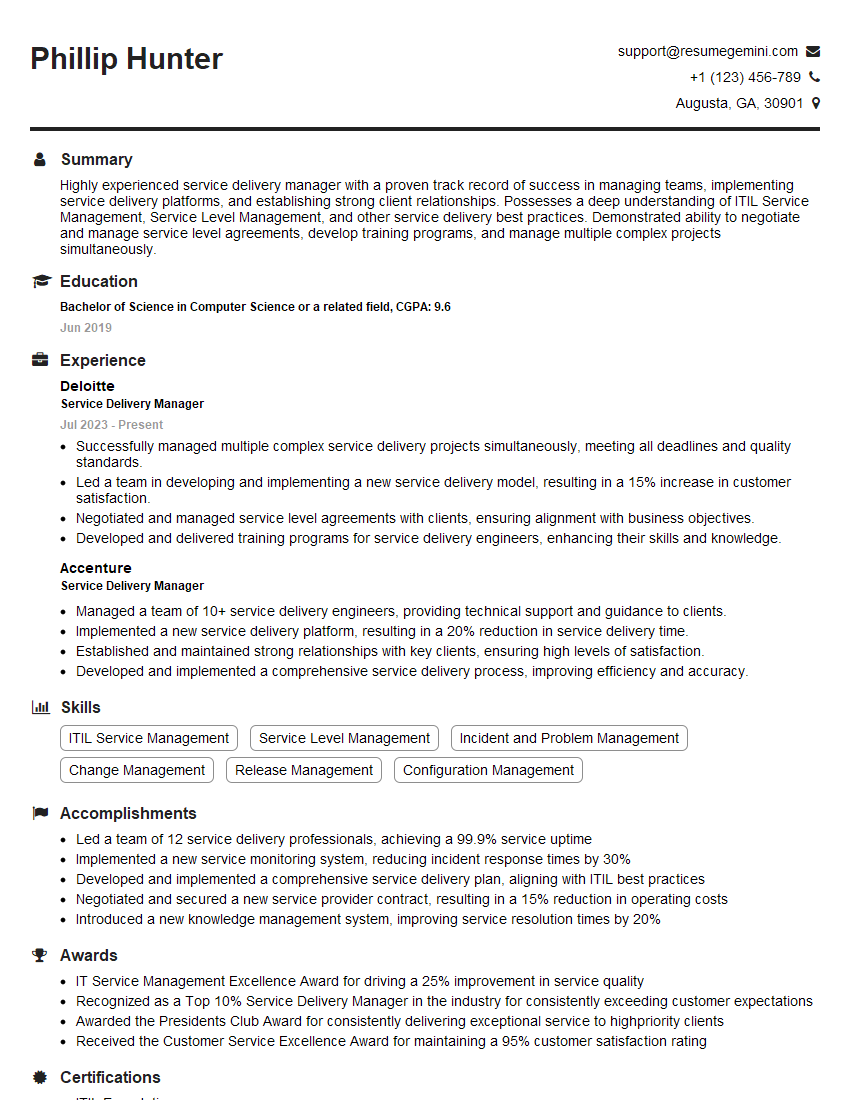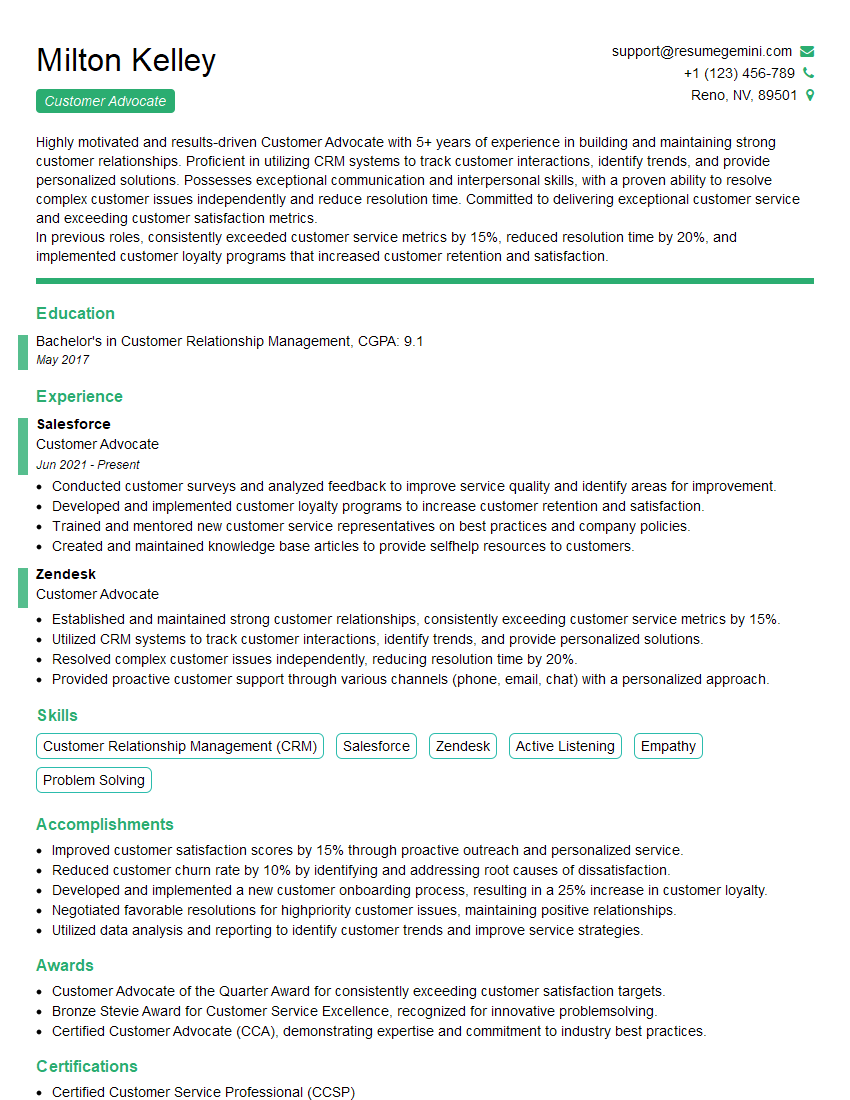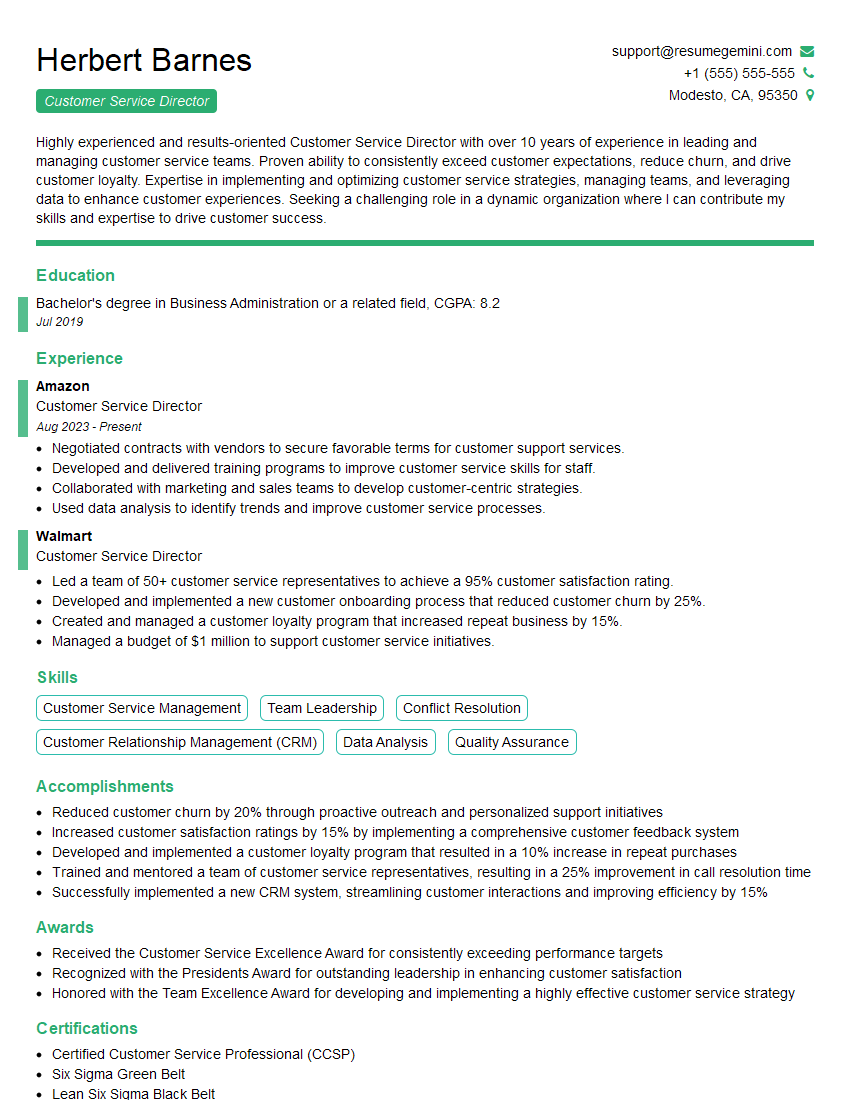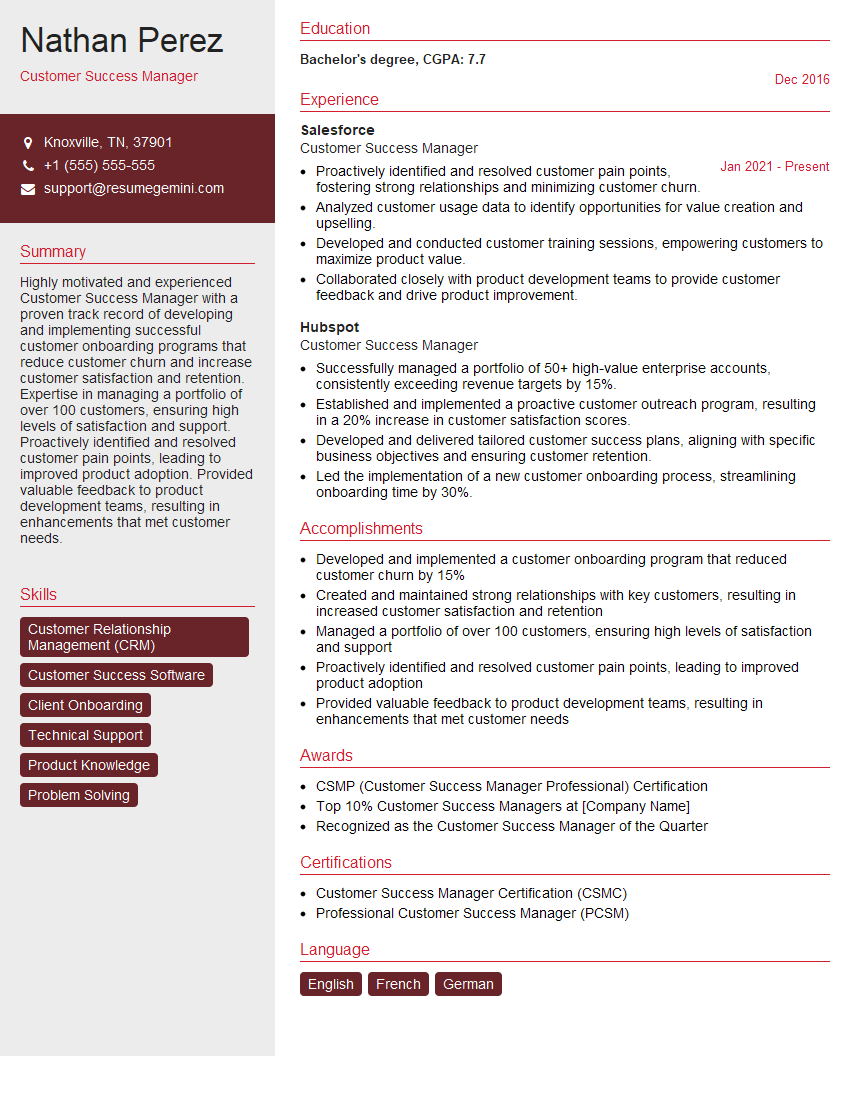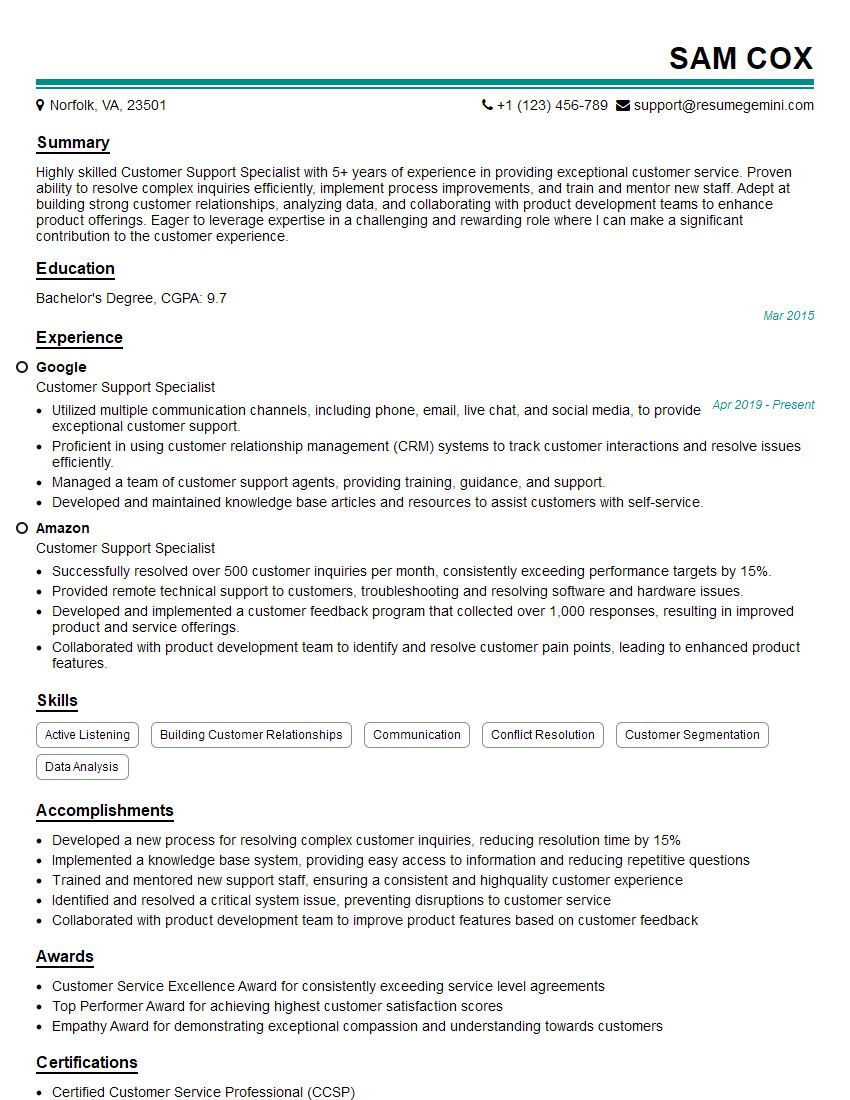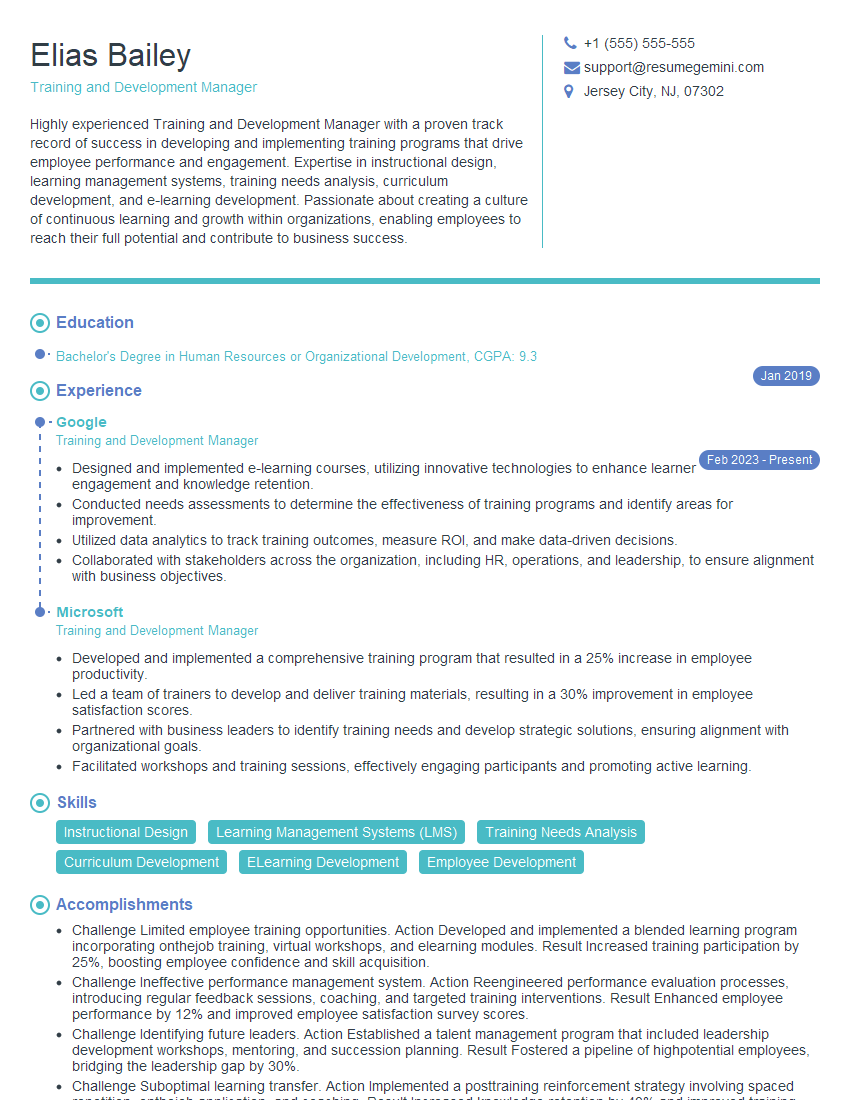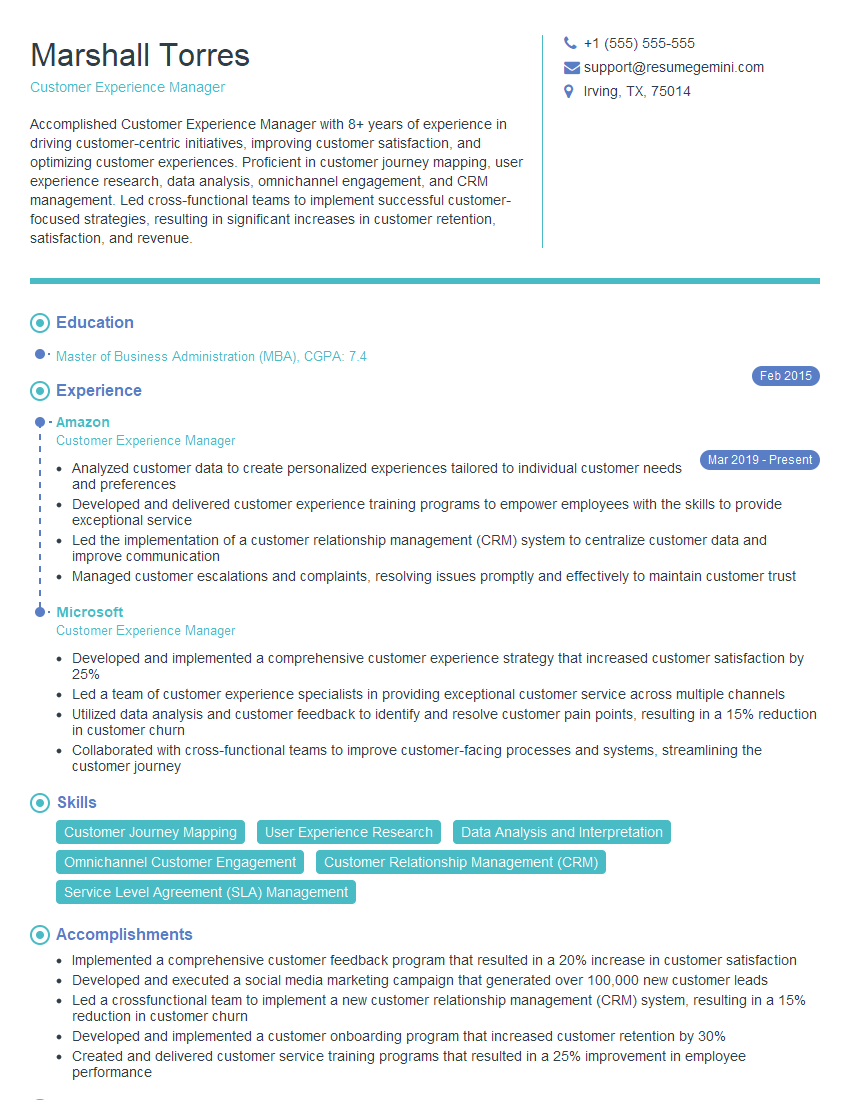Are you ready to stand out in your next interview? Understanding and preparing for Certified Service Excellence Professional (CSEP) interview questions is a game-changer. In this blog, we’ve compiled key questions and expert advice to help you showcase your skills with confidence and precision. Let’s get started on your journey to acing the interview.
Questions Asked in Certified Service Excellence Professional (CSEP) Interview
Q 1. Describe the key principles of Certified Service Excellence.
Certified Service Excellence (CSE) rests on several key principles, all revolving around exceeding customer expectations and creating a culture of service within an organization. These include:
- Customer Focus: Placing the customer at the heart of all decisions and operations. It’s about understanding their needs, preferences, and pain points, and designing services to address them.
- Leadership Commitment: Service excellence requires buy-in from the top down. Leaders must champion the initiative, allocate resources, and actively participate in its implementation.
- Continuous Improvement: CSE isn’t a one-time project; it’s an ongoing process. Regularly assessing performance, identifying areas for improvement, and making adjustments are crucial.
- Empowered Employees: Frontline staff need the authority and resources to resolve customer issues effectively. Empowering employees fosters ownership and improves customer satisfaction.
- Process Excellence: Streamlining processes, eliminating inefficiencies, and ensuring that services are delivered consistently and reliably is key. This might involve using lean methodologies or Six Sigma.
- Results Orientation: Measuring performance against key indicators (KPIs) and using data to track progress and make informed decisions.
- Proactive Communication: Keeping customers informed throughout the service process, proactively addressing potential problems, and fostering open communication channels.
For instance, a company might implement a CRM system to centralize customer data, empower employees with problem-solving authority, and track key metrics such as customer satisfaction scores (CSAT) and Net Promoter Score (NPS).
Q 2. Explain the importance of customer feedback in service excellence.
Customer feedback is the lifeblood of service excellence. It provides invaluable insights into customer perceptions, identifies areas for improvement, and allows organizations to measure the effectiveness of their service initiatives. Without feedback, organizations operate in a vacuum, guessing at what customers want rather than knowing.
Imagine a restaurant that never asks for customer feedback. They might assume their food is excellent, only to discover through declining sales that customers are unhappy with the service or ambiance. Customer feedback helps prevent such situations. It allows for proactive adjustments and prevents larger problems down the line.
Furthermore, responding to feedback shows customers that their opinions are valued, which strengthens the relationship and fosters loyalty. It’s a fundamental aspect of building trust and demonstrating a commitment to continuous improvement.
Q 3. How would you measure customer satisfaction within a service excellence framework?
Measuring customer satisfaction is crucial for demonstrating the effectiveness of service excellence initiatives. A multi-faceted approach is best, combining quantitative and qualitative data.
- Quantitative Measures: These involve numerical data and include:
- Customer Satisfaction Scores (CSAT): Surveys asking customers to rate their satisfaction on a scale (e.g., 1-5 or 1-10).
- Net Promoter Score (NPS): Measures customer loyalty by asking how likely they are to recommend the service.
- Average Handling Time (AHT): Measures the efficiency of service delivery.
- First Contact Resolution (FCR): Measures the percentage of issues resolved on the first contact.
- Qualitative Measures: These provide richer insights into customer experiences and include:
- Customer feedback forms (open-ended questions): Allows for detailed feedback on specific aspects of service.
- Customer interviews: In-depth conversations to understand customer perspectives.
- Social media monitoring: Tracking online conversations to gauge sentiment and identify issues.
By combining these methods, a comprehensive picture of customer satisfaction can be obtained. For example, a high CSAT score coupled with negative comments in open-ended feedback might indicate an area needing attention, even if the overall score is positive.
Q 4. What are the different methods for gathering customer feedback?
There’s a wide array of methods for gathering customer feedback, each with its own strengths and weaknesses. The best approach often involves a combination of techniques to get a holistic view.
- Surveys (online, email, phone): Efficient for gathering large amounts of data, but can be impersonal.
- Feedback forms (online, paper): Allows for both structured and open-ended questions, offering a balance between quantitative and qualitative data.
- Customer interviews: Provide in-depth insights, but are time-consuming and less scalable.
- Focus groups: Useful for exploring specific topics in a group setting, facilitating discussions and brainstorming.
- Social media monitoring: Provides real-time feedback, but requires careful analysis to separate genuine feedback from noise.
- Customer relationship management (CRM) systems: Can track interactions and feedback over time, providing a longitudinal view of customer experiences.
- Mystery shopping: Objective assessment of service quality from a neutral perspective.
For example, a company might use online surveys for regular CSAT measurement, feedback forms on their website for specific issues, and customer interviews to understand the root causes of negative feedback.
Q 5. How do you handle difficult or angry customers?
Handling difficult or angry customers requires empathy, patience, and a structured approach. The goal is to de-escalate the situation, understand their concerns, and find a mutually acceptable resolution. Here’s a step-by-step approach:
- Listen empathetically: Let the customer vent their frustration without interruption. Acknowledge their feelings and validate their concerns. Show you’re genuinely trying to understand their perspective.
- Apologize sincerely: Even if you don’t believe the company is at fault, apologizing for the customer’s negative experience shows empathy and willingness to help. Focus on the impact of the situation on the customer, not on assigning blame.
- Take ownership: Avoid making excuses or placing blame. Instead, take responsibility for resolving the issue, even if it’s not directly your fault.
- Find a solution: Work collaboratively with the customer to find a solution that meets their needs. This might involve offering a refund, replacement, or other compensation. Clearly communicate the steps you’ll take to resolve the problem.
- Follow up: After the immediate issue is resolved, follow up with the customer to ensure they are satisfied and to address any lingering concerns. This shows commitment to customer satisfaction and helps build rapport.
For example, if a customer is angry about a delayed delivery, you might sincerely apologize for the inconvenience, offer a discount on their next order, and provide a tracking update. The key is to demonstrate genuine care and commitment to finding a positive resolution.
Q 6. Describe your experience in implementing service excellence initiatives.
In my previous role at [Company Name], I led the implementation of a comprehensive service excellence program. This involved several key initiatives:
- Employee training: We implemented a new training program focused on customer service skills, including active listening, empathy, and conflict resolution. This involved role-playing scenarios and providing ongoing coaching and support.
- Process improvement: We streamlined several key processes to reduce wait times and improve efficiency. This included implementing a new CRM system to track customer interactions and automate certain tasks.
- Customer feedback mechanisms: We introduced multiple channels for collecting customer feedback, including online surveys, feedback forms, and social media monitoring. We also implemented a system for promptly responding to customer feedback and addressing concerns.
- KPI development and monitoring: We defined key performance indicators (KPIs) such as CSAT, NPS, and FCR, and established a system for regularly monitoring and reporting on progress. This data informed our continuous improvement efforts.
The result was a significant increase in customer satisfaction, as measured by our CSAT and NPS scores, along with a reduction in customer complaints and improved employee morale. This demonstrates the tangible benefits of a well-executed service excellence program.
Q 7. How do you identify areas for improvement in customer service processes?
Identifying areas for improvement in customer service requires a systematic approach that combines data analysis with qualitative feedback. Here are some key strategies:
- Analyze customer feedback data: Review customer surveys, feedback forms, and social media comments to identify recurring themes and pain points. Look for patterns in negative feedback to pinpoint specific areas needing attention.
- Track key performance indicators (KPIs): Monitor KPIs such as CSAT, NPS, AHT, and FCR to identify areas where performance is lagging. Significant drops in these metrics can signal underlying issues.
- Conduct customer interviews or focus groups: Gain deeper insights into customer experiences by conducting in-depth interviews or focus groups. This qualitative data can provide context and explanations for trends observed in quantitative data.
- Analyze service process data: Examine internal data, such as call logs, ticket resolution times, and employee performance metrics, to identify bottlenecks and inefficiencies in service delivery processes.
- Mystery shopping: Use mystery shoppers to evaluate service quality from an objective perspective. This provides an external view of the customer experience.
- Employee feedback: Gather input from frontline employees about their experiences and challenges in serving customers. Their perspectives often offer valuable insights into operational issues.
For example, if analysis reveals consistently low scores on a particular aspect of service (e.g., website navigation), this signals a need for improvements in that specific area. By systematically analyzing data from various sources, you can prioritize areas for improvement and allocate resources effectively.
Q 8. What are some common challenges in achieving service excellence?
Achieving service excellence is a continuous journey, not a destination. Common challenges include inconsistent service delivery across teams, inadequate staff training, a lack of clear service standards, ineffective communication, difficulty in measuring success, and resistance to change within the organization. Think of it like baking a cake: if your recipe (service standards) isn’t clear, your ingredients (staff) aren’t top-quality, or your oven temperature (processes) isn’t consistent, you won’t get a perfect cake every time.
- Inconsistent Service Delivery: Different teams or individuals may interpret service standards differently, leading to inconsistencies in customer experience. This is like having multiple cooks with varying interpretations of the same recipe.
- Inadequate Staff Training: Without proper training, employees might lack the skills and knowledge to deliver excellent service. It’s like sending a baker to make a cake without teaching them basic baking techniques.
- Lack of Clear Service Standards: Without defined standards, measuring success and ensuring consistency is nearly impossible. It’s akin to baking without a recipe—you’re relying solely on intuition.
- Ineffective Communication: Poor communication between teams and with customers can lead to misunderstandings and frustration. This is like not having clear communication between different parts of the kitchen, causing recipe misinterpretations or delays.
- Difficulty Measuring Success: Without quantifiable metrics, it’s hard to assess the effectiveness of service excellence initiatives and identify areas for improvement. It’s like baking without knowing what constitutes a ‘good’ cake—you have no benchmark to measure against.
- Resistance to Change: Employees may be resistant to adopting new processes or technologies, hindering progress towards service excellence. This is like a baker refusing to use new, more efficient baking equipment, clinging to outdated methods.
Q 9. How do you measure the success of service excellence initiatives?
Measuring the success of service excellence initiatives requires a multi-faceted approach using both quantitative and qualitative data. We need to understand not only *what* we’re achieving, but also *how* we’re achieving it. Key metrics can include customer satisfaction scores (CSAT), Net Promoter Score (NPS), customer effort score (CES), and resolution times. Qualitative data, such as customer feedback, employee surveys, and internal audits, provide valuable insights into the underlying causes of both successes and failures.
- Customer Satisfaction (CSAT): Surveys asking customers to rate their satisfaction with the service received.
- Net Promoter Score (NPS): Measures customer loyalty and willingness to recommend the service.
- Customer Effort Score (CES): Measures the ease with which customers can resolve their issues.
- Resolution Times: Tracks the time taken to resolve customer issues.
- Employee Satisfaction Surveys: Gauges employee morale and their perception of the effectiveness of service initiatives.
- Customer Feedback Analysis: Examining written feedback (e.g., reviews, emails) for themes and patterns.
By combining quantitative and qualitative data, a holistic view of service excellence performance can be obtained, allowing for data-driven decision-making and continuous improvement.
Q 10. Explain the importance of teamwork in providing excellent customer service.
Teamwork is the cornerstone of excellent customer service. A well-functioning team, with clearly defined roles and responsibilities, can provide seamless and efficient support. Think of a symphony orchestra: each section (team member) plays its part, but the beautiful music (excellent customer service) only emerges through coordinated effort.
- Shared Responsibility: A collaborative environment ensures that no customer falls through the cracks. If one team member is unavailable, another can step in to assist.
- Knowledge Sharing: Team members can learn from each other’s experiences, building a collective expertise that benefits all customers.
- Faster Resolution Times: Multiple perspectives can help solve complex issues more efficiently and effectively.
- Improved Morale: A supportive team environment boosts morale and reduces stress, leading to happier employees who provide better service.
- Enhanced Customer Experience: Seamless handoffs between teams and consistent communication create a positive and satisfying customer experience.
In essence, teamwork fosters a culture of support and collaboration, ultimately leading to a superior customer experience.
Q 11. Describe your experience with customer service technology and tools.
My experience encompasses a range of customer service technologies and tools, including CRM systems (e.g., Salesforce, Zendesk), help desk software (e.g., Freshdesk, Jira Service Desk), live chat platforms (e.g., Intercom, Drift), and knowledge base systems (e.g., Document360, Confluence). I’m proficient in utilizing these tools to manage customer interactions, track inquiries, gather data, automate processes, and provide efficient support. For instance, I’ve used Salesforce to manage customer accounts, track interactions, and analyze trends to improve service delivery. My expertise extends to integrating these systems to create a streamlined workflow, improving efficiency and data accuracy. In a previous role, we integrated our CRM with our live chat platform, allowing us to provide personalized assistance based on a customer’s past interactions. This level of personalization significantly improved customer satisfaction.
Q 12. How do you ensure consistent service delivery across different teams or departments?
Ensuring consistent service delivery across different teams and departments requires a well-defined framework based on clear service level agreements (SLAs), standardized processes, regular training, and effective communication. Imagine it as building a bridge: consistent design and materials (standardized processes) are crucial to ensure structural integrity (consistent service delivery) across its length (different teams).
- Service Level Agreements (SLAs): Establish clear expectations for service delivery, specifying response times, resolution times, and other key metrics for each team.
- Standardized Processes: Develop and implement consistent procedures for handling common customer issues, reducing variability across teams.
- Regular Training: Provide ongoing training to ensure that all employees understand and adhere to the service standards and processes. This includes regular refresher courses and updates on new processes or technologies.
- Effective Communication: Establish clear communication channels between teams, enabling efficient collaboration and information sharing. Regular cross-team meetings and shared documentation can facilitate this.
- Regular Audits: Conduct regular audits to ensure compliance with service standards and identify areas for improvement. This could involve reviewing customer feedback, monitoring performance metrics, and conducting mystery shopping exercises.
By implementing these strategies, organizations can create a culture of consistency, ensuring that customers receive the same high level of service regardless of which team or department they interact with.
Q 13. How do you stay up-to-date on industry best practices in service excellence?
Staying abreast of industry best practices in service excellence is crucial for continuous improvement. I actively participate in industry events and conferences, such as those hosted by organizations focused on customer service excellence. I regularly read industry publications, follow thought leaders on social media, and participate in online forums and communities related to customer service. I also leverage professional development opportunities, such as certifications (like the CSEP) and online courses to expand my knowledge and stay ahead of the curve. This commitment to lifelong learning allows me to adopt innovative approaches and solutions, continuously improving my skillset and applying the latest techniques to enhance service delivery. I believe in staying updated with new technologies and trends to further elevate customer experiences.
Q 14. Describe a time you had to resolve a complex customer service issue.
In a previous role, we faced a complex issue involving a critical software failure impacting a large number of our clients. The issue was multifaceted, involving both technical and communication challenges. The initial technical diagnosis was complicated and required close collaboration with the development and IT teams. Simultaneously, we needed to manage frustrated customers, many of whom were experiencing significant business disruption. My approach involved:
- Establishing a central communication hub: We created a dedicated communication channel to provide regular updates to affected clients and proactively addressed their concerns.
- Forming a cross-functional team: We assembled a team comprising representatives from technical support, development, communications, and management to collaboratively address the issue.
- Implementing a tiered escalation process: We established clear escalation pathways for complex issues, ensuring that experienced staff could handle critical situations efficiently.
- Prioritizing communication transparency: We communicated clearly and transparently with clients, providing regular updates on the progress of the investigation and remediation efforts.
- Implementing compensatory measures: We offered clients compensatory measures to mitigate the disruption caused by the software failure.
Through collaborative teamwork, transparent communication, and a well-defined process, we were able to successfully resolve the issue, minimizing customer disruption and maintaining trust in our service.
Q 15. What is your understanding of customer journey mapping?
Customer journey mapping is a visual representation of the steps a customer takes to interact with your business, from initial awareness to post-purchase engagement. It’s not just about the purchase itself but the entire experience. Think of it like a detailed roadmap of your customer’s experience. A well-crafted map highlights touchpoints (where customers interact with your brand – website, phone, social media, etc.), pain points (areas of friction or frustration), and opportunities for improvement.
For example, imagine a customer buying a new phone. The journey might start with online research, then a visit to a store, followed by the purchase, activation, and ongoing use. A customer journey map would visually chart all these steps, noting any issues—like a confusing website, unhelpful staff, or difficult activation process—and suggest solutions, like improved online tutorials or more thorough staff training.
By understanding the entire journey, businesses can identify areas needing attention and proactively improve the customer experience, leading to increased loyalty and positive word-of-mouth referrals. It’s a crucial tool for improving service excellence, aligning perfectly with the CSEP principles.
Career Expert Tips:
- Ace those interviews! Prepare effectively by reviewing the Top 50 Most Common Interview Questions on ResumeGemini.
- Navigate your job search with confidence! Explore a wide range of Career Tips on ResumeGemini. Learn about common challenges and recommendations to overcome them.
- Craft the perfect resume! Master the Art of Resume Writing with ResumeGemini’s guide. Showcase your unique qualifications and achievements effectively.
- Don’t miss out on holiday savings! Build your dream resume with ResumeGemini’s ATS optimized templates.
Q 16. How do you use data to drive improvements in customer service?
Data is the lifeblood of improving customer service. I leverage various data sources – customer surveys, call center analytics, website analytics, social media sentiment analysis – to understand customer behavior and pinpoint areas for improvement. For instance, high call abandonment rates in a call center indicate potential problems with wait times or agent training. Low customer satisfaction scores on surveys highlight specific service shortcomings.
I use this data to create dashboards and reports that visualize key performance indicators (KPIs) such as average handling time, customer satisfaction (CSAT) scores, Net Promoter Score (NPS), and first-call resolution rates. By analyzing trends and patterns in this data, I identify areas needing immediate attention and prioritize improvements. For example, if NPS scores are consistently low after a product launch, I might commission further customer research to understand the root causes and develop targeted solutions. This data-driven approach helps ensure our improvements are focused and effective.
Q 17. Explain your approach to managing customer expectations.
Managing customer expectations is about setting realistic and clear expectations upfront and consistently delivering on them. It’s about transparency and communication. I believe in proactively setting expectations by clearly communicating timelines, processes, and potential outcomes. For example, if a customer needs a repair, I’d clearly outline the estimated repair time, explain the process involved, and communicate any potential delays proactively.
Under-promising and over-delivering is a good strategy. If I can resolve a problem faster than expected, it creates a positive surprise for the customer. Regular communication throughout the process, such as automated email updates or direct calls, ensures customers are always informed and reduces uncertainty, preventing misunderstandings and building trust. This approach aligns with the principles of exceeding customer expectations in the CSEP framework.
Q 18. What is your experience with service level agreements (SLAs)?
Service Level Agreements (SLAs) are formal contracts outlining the expected performance levels of a service provider. My experience involves negotiating, implementing, and monitoring SLAs across various service areas. This includes defining key metrics such as response times, resolution times, and availability, setting targets for each metric, and establishing penalties for non-compliance.
For example, an SLA for a help desk might specify a 95% first-call resolution rate, a maximum response time of 30 minutes, and a 99.9% system uptime. I use monitoring tools to track performance against the defined SLAs and identify any deviations. Regular reporting and review meetings with stakeholders help ensure the SLAs remain relevant and effective. Effective SLAs are essential for delivering consistent, high-quality service and improving accountability.
Q 19. How do you handle complaints and negative feedback effectively?
Handling complaints and negative feedback effectively is crucial for retaining customers and maintaining a positive brand image. My approach follows a structured process: First, I actively listen to the customer’s complaint without interruption, showing empathy and understanding. I acknowledge their feelings and validate their concerns. Then, I thoroughly investigate the issue, gathering all necessary information.
Once the facts are established, I propose a solution that aims to resolve the issue fairly and quickly. This might involve a refund, a replacement, or an apology, depending on the situation. Finally, I follow up with the customer to ensure they are satisfied with the resolution and to gather feedback on the process. Even negative feedback offers valuable learning opportunities to improve service processes and prevent similar issues in the future. Transparency and prompt action are key in this process.
Q 20. How do you motivate and support your customer service team?
Motivating and supporting a customer service team requires a multi-pronged approach. Firstly, I foster a positive and supportive work environment, where team members feel valued and respected. I believe in recognizing and rewarding good performance, both individually and as a team. This could involve verbal praise, bonuses, or opportunities for professional development.
Secondly, I invest in their training and development, providing them with the skills and knowledge they need to succeed. This includes product knowledge training, communication skills workshops, and training on new technologies. Regular team meetings, where I solicit feedback and address concerns, help ensure open communication and a sense of shared purpose. Finally, I empower my team to make decisions and take ownership of their work, promoting a culture of autonomy and responsibility. A motivated and well-supported team is crucial for delivering excellent customer service.
Q 21. What is your experience with quality management systems?
My experience with quality management systems (QMS) is extensive. I’m familiar with various frameworks, including ISO 9001. I understand the importance of establishing clear processes, documenting procedures, and regularly monitoring performance against quality standards. I am comfortable with quality audits, root cause analysis (RCA), and continuous improvement methodologies such as Plan-Do-Check-Act (PDCA).
In practice, this involves implementing systems to track customer feedback, identifying and addressing process inefficiencies, and regularly reviewing procedures to ensure they remain relevant and effective. I use data analytics to monitor key quality metrics and identify areas needing improvement. The goal is always to continuously improve service quality and exceed customer expectations. Implementing and managing a QMS ensures consistent service delivery and demonstrates a commitment to excellence – key aspects of the CSEP certification.
Q 22. Explain your understanding of root cause analysis.
Root cause analysis (RCA) is a systematic process for identifying the underlying causes of problems, rather than just addressing surface-level symptoms. Think of it like peeling an onion – you keep removing layers until you reach the core issue. In a CSEP context, this is crucial for preventing recurring customer service problems.
A common RCA methodology is the ‘5 Whys’. You repeatedly ask ‘Why?’ to drill down to the root cause. For example: A customer complains about a late delivery (Symptom). Why? Because the warehouse was short-staffed. Why? Because two employees called in sick. Why? Because the company’s wellness program isn’t engaging enough. Why? Because employees don’t feel valued. The root cause, therefore, might be a lack of employee engagement, not simply staffing shortages on that particular day.
Other techniques include fishbone diagrams (Ishikawa diagrams), fault tree analysis, and Pareto charts. The chosen method depends on the complexity of the problem and the available data. Effective RCA requires collaboration, data analysis, and a commitment to finding the true underlying cause to implement lasting solutions and improve customer service.
Q 23. How do you use technology to improve the customer experience?
Technology plays a vital role in enhancing the customer experience. I’ve utilized several technologies to streamline processes and improve customer interactions. For example, implementing a robust knowledge base accessible to both customers (through a self-service portal) and agents significantly reduces resolution times and improves customer satisfaction. This allows customers to find answers quickly and efficiently, without needing to contact an agent.
Live chat software allows for immediate responses to customer inquiries, fostering a sense of urgency and responsiveness. Customer relationship management (CRM) systems, as discussed later, provide a centralized repository of customer information, allowing agents to personalize interactions and resolve issues more efficiently. Finally, utilizing AI-powered chatbots for initial inquiries can handle simple questions and free up human agents for more complex issues, leading to improved efficiency and reduced wait times.
Q 24. Describe your experience with customer relationship management (CRM) systems.
My experience with CRM systems is extensive. I’ve worked with Salesforce, Zendesk, and HubSpot, implementing and customizing them to optimize customer service workflows. These systems are far more than just contact databases; they are integral to effective customer service strategies. I’ve used them to track customer interactions, analyze trends, personalize communications, and manage customer lifecycle stages. For example, in a previous role, I customized our Salesforce instance to automatically trigger automated emails based on customer actions, such as abandoned shopping carts or post-purchase follow-ups, leading to a significant increase in sales and customer retention.
Furthermore, CRM systems provide valuable data for root cause analysis. By analyzing data points such as customer feedback, contact frequency, and resolution times, we can identify areas for improvement in our processes and tailor our strategies to better meet customer needs. Effective use of CRM systems is key to providing exceptional customer service and optimizing business outcomes.
Q 25. What is your experience with process improvement methodologies like Lean or Six Sigma?
I’ve successfully applied Lean and Six Sigma methodologies to improve customer service processes. Lean focuses on eliminating waste and maximizing value for the customer, while Six Sigma aims to reduce defects and variability. I’ve used Lean principles like value stream mapping to identify bottlenecks in our processes, such as excessively long wait times or complicated escalation procedures. By streamlining these processes, we reduced handling time and increased customer satisfaction.
In applying Six Sigma, I’ve utilized DMAIC (Define, Measure, Analyze, Improve, Control) to systematically tackle service issues. For example, I defined a problem of high call abandonment rates, measured the current rate, analyzed contributing factors through surveys and call recordings, implemented solutions such as improved IVR systems and additional agent training, and then controlled the improvements to sustain the gains. Both methodologies offer a data-driven approach to continuous improvement and enhance customer experience.
Q 26. How do you balance customer satisfaction with business objectives?
Balancing customer satisfaction with business objectives is a crucial aspect of effective customer service. It’s not a zero-sum game; in fact, high customer satisfaction often leads to improved business outcomes. My approach involves aligning customer service strategies with overall business goals. For instance, if a business objective is increased customer retention, customer service strategies should focus on building strong customer relationships and providing excellent post-purchase support.
I use data-driven insights to inform decisions. For example, if analysis shows that a particular service enhancement would significantly improve customer satisfaction while having a manageable impact on costs, it would be a worthwhile investment. Conversely, if a proposed initiative would improve customer satisfaction marginally but negatively impact profitability, it might not be justified. The key is to find a balance that maximizes both customer satisfaction and business profitability.
Q 27. Describe your experience with change management related to customer service initiatives.
Change management is crucial for successful customer service initiatives. I approach this by following a structured process, typically involving communication, training, and monitoring. My experience includes implementing new CRM systems, launching new self-service portals, and introducing new service processes. In each case, I ensured clear communication to all stakeholders – customers, agents, and management – well in advance of the change.
Comprehensive training programs for agents are vital to ensure smooth transitions and effective adoption of new systems or processes. For instance, when implementing a new CRM, we conducted extensive training sessions, followed by ongoing support and regular feedback sessions. Post-implementation monitoring helps identify areas needing adjustments and allows for continuous improvement. Ignoring this critical step frequently leads to failure in change management initiatives.
Q 28. How do you develop and maintain strong customer relationships?
Building and maintaining strong customer relationships is paramount. I focus on personalized interactions, proactive communication, and consistent follow-up. Personalization goes beyond using a customer’s name; it’s about understanding their individual needs and preferences. For example, analyzing past interactions can help anticipate future needs and proactively address potential issues. Proactive communication, such as sending targeted emails or follow-up calls, demonstrates attentiveness and care.
Consistent follow-up, especially after resolving an issue or completing a transaction, reinforces a positive customer experience and builds loyalty. Using customer feedback mechanisms, like surveys and reviews, provides valuable insights into customer satisfaction levels and allows for improvement in our strategies. In essence, building strong relationships requires a customer-centric approach, focusing on empathy, understanding, and continuous improvement to foster long-term loyalty.
Key Topics to Learn for Certified Service Excellence Professional (CSEP) Interview
Ace your CSEP interview by mastering these key areas. Remember, practical application is key – think about how you’ve demonstrated these concepts in your past experiences.
- Understanding Customer Needs: Go beyond surface-level requests. Explore techniques for active listening, empathy, and identifying underlying customer needs.
- Service Design & Delivery: Learn how to design efficient and effective service processes. Consider how to streamline workflows and optimize customer interactions.
- Communication & Relationship Building: Mastering clear, concise, and empathetic communication is crucial. Practice techniques for building rapport and managing difficult conversations.
- Problem Solving & Conflict Resolution: Develop strategies for identifying, analyzing, and resolving service issues efficiently and effectively. Practice handling customer complaints and finding mutually agreeable solutions.
- Performance Measurement & Improvement: Understand key performance indicators (KPIs) within a service context. Learn how to analyze data to identify areas for improvement and implement effective change.
- Teamwork & Collaboration: Explore effective teamwork strategies and techniques for collaborating with colleagues to deliver excellent service. Discuss examples where you contributed to a team effort.
- Service Innovation & Continuous Improvement: Discuss approaches for innovating service offerings and incorporating continuous improvement methodologies to enhance customer experience.
Next Steps
Earning your CSEP certification significantly boosts your career prospects, opening doors to leadership roles and demonstrating your commitment to excellence in service. A strong resume is crucial for landing your dream job. Make sure yours is ATS-friendly (Applicant Tracking System-friendly) to ensure it gets noticed by recruiters.
To create a compelling, ATS-friendly resume that showcases your CSEP skills and experience, leverage the power of ResumeGemini. ResumeGemini provides a trusted and intuitive platform for building professional resumes. We offer examples of resumes specifically tailored to the Certified Service Excellence Professional (CSEP) certification to help you get started. Take the next step towards your successful career today!
Explore more articles
Users Rating of Our Blogs
Share Your Experience
We value your feedback! Please rate our content and share your thoughts (optional).
What Readers Say About Our Blog
Take a look at this stunning 2-bedroom apartment perfectly situated NYC’s coveted Hudson Yards!
https://bit.ly/Lovely2BedsApartmentHudsonYards
Live Rent Free!
https://bit.ly/LiveRentFREE
Interesting Article, I liked the depth of knowledge you’ve shared.
Helpful, thanks for sharing.
Hi, I represent a social media marketing agency and liked your blog
Hi, I represent an SEO company that specialises in getting you AI citations and higher rankings on Google. I’d like to offer you a 100% free SEO audit for your website. Would you be interested?





